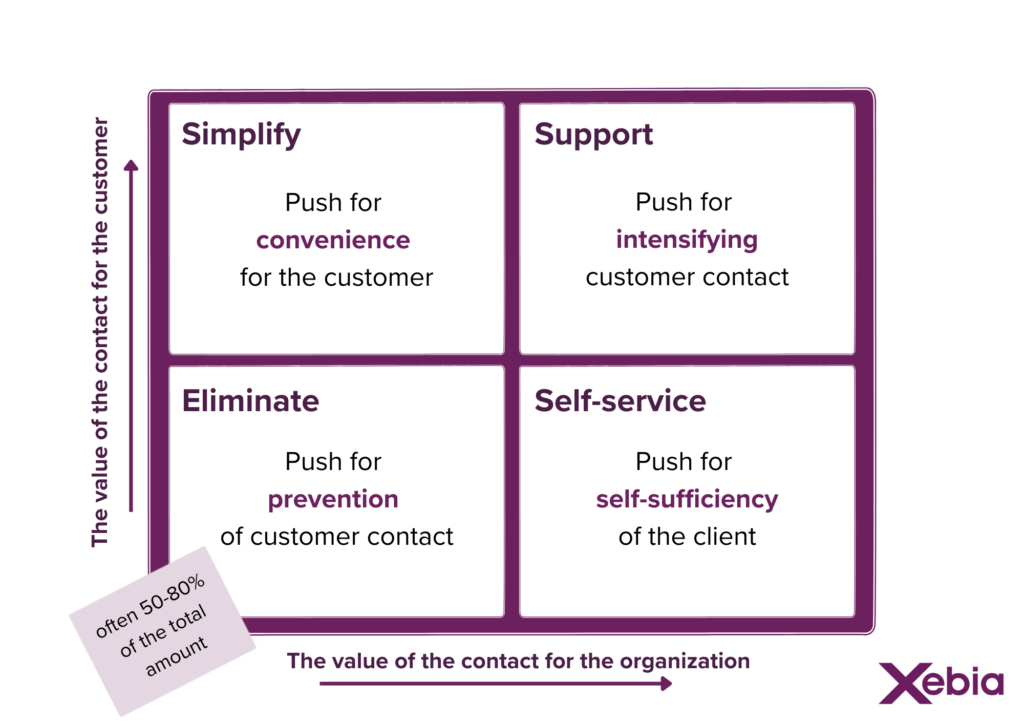Lessons Learned From Over 100 Implementations
At Xebia, we have done over 100 Freshdesk, Freshchat and Freshservice implementations since 2014. All these implementations have had their own reasons for companies, such as customer contact prevention. But in the end we have seen that four of these reasons came back almost every time.
- More grip on the operations
- Lower costs of customer contact
- Improved customer experience
- Improved employee experience
The first blog focused on improving operational control. The previous blog covered the first part about reducing the costs of customer contact. It described how a focus on the quality of customer contact can lead to lower costs and, consequently, a competitive advantage. It is important to manage the service cost ratio, which is calculated as (amount of customer contacts * cost per contact) / transactions. Two areas of quality were identified to improve the service cost ratio:
- Customer contact prevention
- And reducing the cost per contact.
This blog focuses on contact prevention.
Why customer contact prevention?
The formula for the service cost ratio is (amount of customer contacts * cost per contact) / transactions. It is clear that if we maintain or reduce the number of customer contacts while the number of transactions increases, the organization becomes more scalable.
Contact Prevention Matrix
A good initial step towards contact prevention is gaining insight into which types of contact you want to prevent and which types are valuable to you. To do this, you can plot customer contacts on a matrix. The vertical axis represents the value of the contact for the organization. While the horizontal axis represents the value of the contact for the customer. This creates four quadrants.
Let us explain the matrix a little bit more in-depth. The bottom-left of the matrix shown below, contains contacts you want to eliminate. The bottom-right quadrant is important only for the customer, and these contacts should be addressed through self-service. The top-left part represents types of contact that are important for the organization but not for the customer. These types of contact should be simplified. Finally, the top-right quadrant contains types that are valuable to both the customer and the organization. These contacts should definitely be encouraged in our opinion.

Self-service as a key focus point in contact prevention
Once you have plotted your contact moments on the matrix, you proceed with the next step. A second action to prevent live contact moments is to focus on the contact moments that are valuable to the customer but less for the organization. These will be prevented through self-service. Examples of self-service from Freshdesk include:
- Offering articles from a database;
- Providing chatbots on the website, mobile app, or social channels like WhatsApp and Facebook Messenger.
Chatbots as a supporter for self-service
When implementing a chatbot, a common starting point for our customers is to identify the top 10 to 20 most commonly rated contact moments. Some of these contact moments will fall into the "self-service" part of the matrix. It is helpful if you categorize them in your ticket fields to easily track their effectiveness in the future. Initially, select a maximum of three contact moments to set up in the chatbot in the first place. To achieve actual results make sure you focus on people, processes, and technology.
Ownership for contact prevention across silos
As a third component, focusing on process or product improvements in other departments is valuable. The majority of customer contacts are not caused by the customer contact department itself; they result from mistakes or unclear communication from other departments. To prevent contact moments, it is essential to make other departments co-owners of the problem and provide them with an opportunity to learn from the mistakes faced by the customer service department.
Unfortunately, organizations are often organized in silos. Which means departments are often unaware of what they can learn from current customer contacts, let alone feeling ownership of the problems.
Knowledge sharing in periodic meetings
To address this, some of our customers use a combination of ticket categorization and analytics reports. They assign different departments as "owners" to various categories, such as returns, payments, or assortment. Monthly, an analytics report is automatically generated for each department. This report is then discussed to identify improvements in the organization that reduce the number of customer contacts. A good practice is to involve employees with customer contact in these discussions so that experiences, emotions, and solutions will be shared alongside the data.
What to expect in our next blog?
In this third blog of our blog series, we have described how customer contact prevention contributes to achieving a good service-cost ratio. In addition to contact prevention, reducing the cost per contact also plays an important role, which we will address in our upcoming blog.





